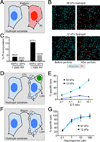Cytotoxic T Cells Use Mechanical Force to Potentiate Target Cell Killing
- PMID: 26924577
- PMCID: PMC4808403
- DOI: 10.1016/j.cell.2016.01.021
Cytotoxic T Cells Use Mechanical Force to Potentiate Target Cell Killing
Abstract
The immunological synapse formed between a cytotoxic T lymphocyte (CTL) and an infected or transformed target cell is a physically active structure capable of exerting mechanical force. Here, we investigated whether synaptic forces promote the destruction of target cells. CTLs kill by secreting toxic proteases and the pore forming protein perforin into the synapse. Biophysical experiments revealed a striking correlation between the magnitude of force exertion across the synapse and the speed of perforin pore formation on the target cell, implying that force potentiates cytotoxicity by enhancing perforin activity. Consistent with this interpretation, we found that increasing target cell tension augmented pore formation by perforin and killing by CTLs. Our data also indicate that CTLs coordinate perforin release and force exertion in space and time. These results reveal an unappreciated physical dimension to lymphocyte function and demonstrate that cells use mechanical forces to control the activity of outgoing chemical signals.
Copyright © 2016 Elsevier Inc. All rights reserved.
Figures







Comment in
-
Embracing the Enemy: Cell-to-Cell Force Transmission Enhances Cytotoxicity.Dev Cell. 2016 Mar 21;36(6):592-4. doi: 10.1016/j.devcel.2016.03.007. Dev Cell. 2016. PMID: 27003932
References
Publication types
MeSH terms
Substances
Grants and funding
LinkOut - more resources
Full Text Sources
Other Literature Sources

